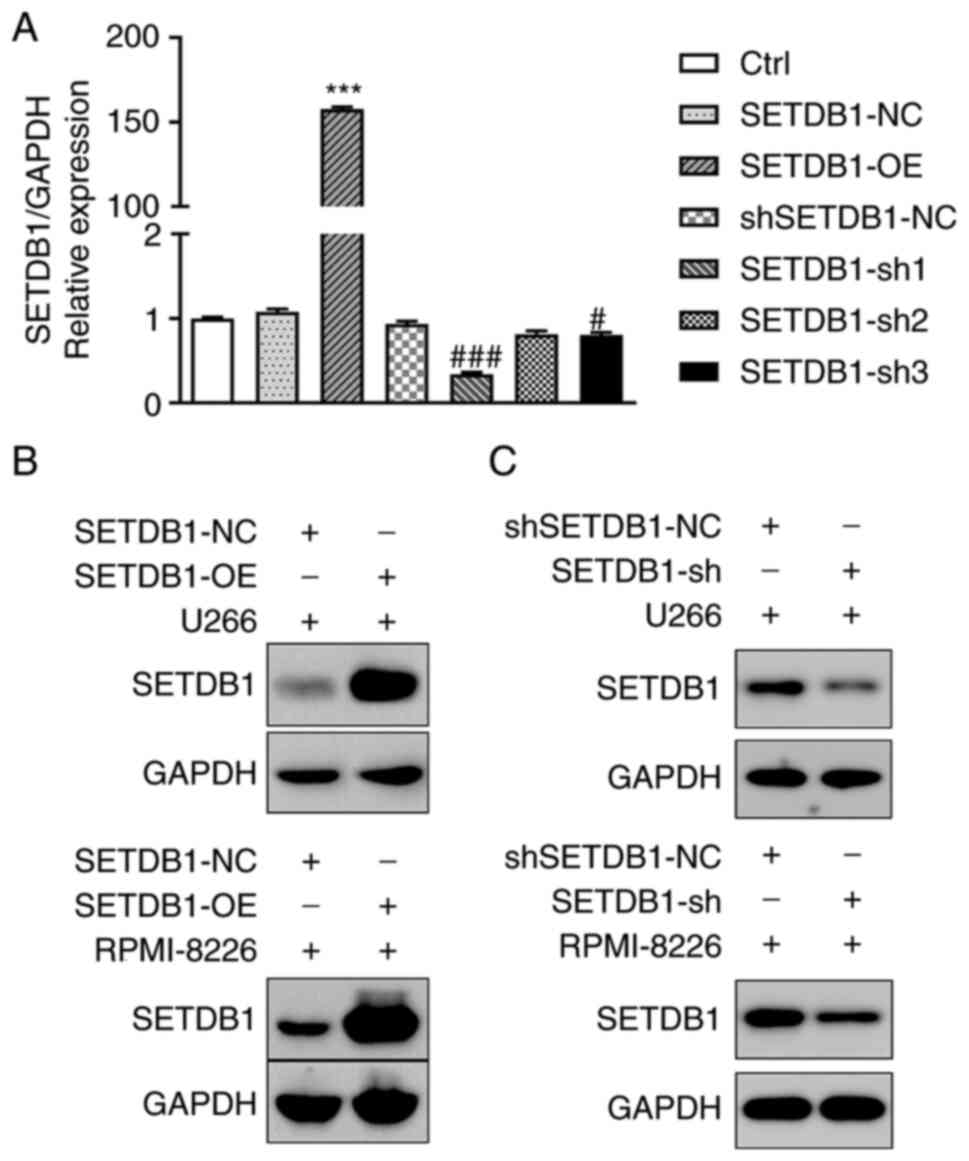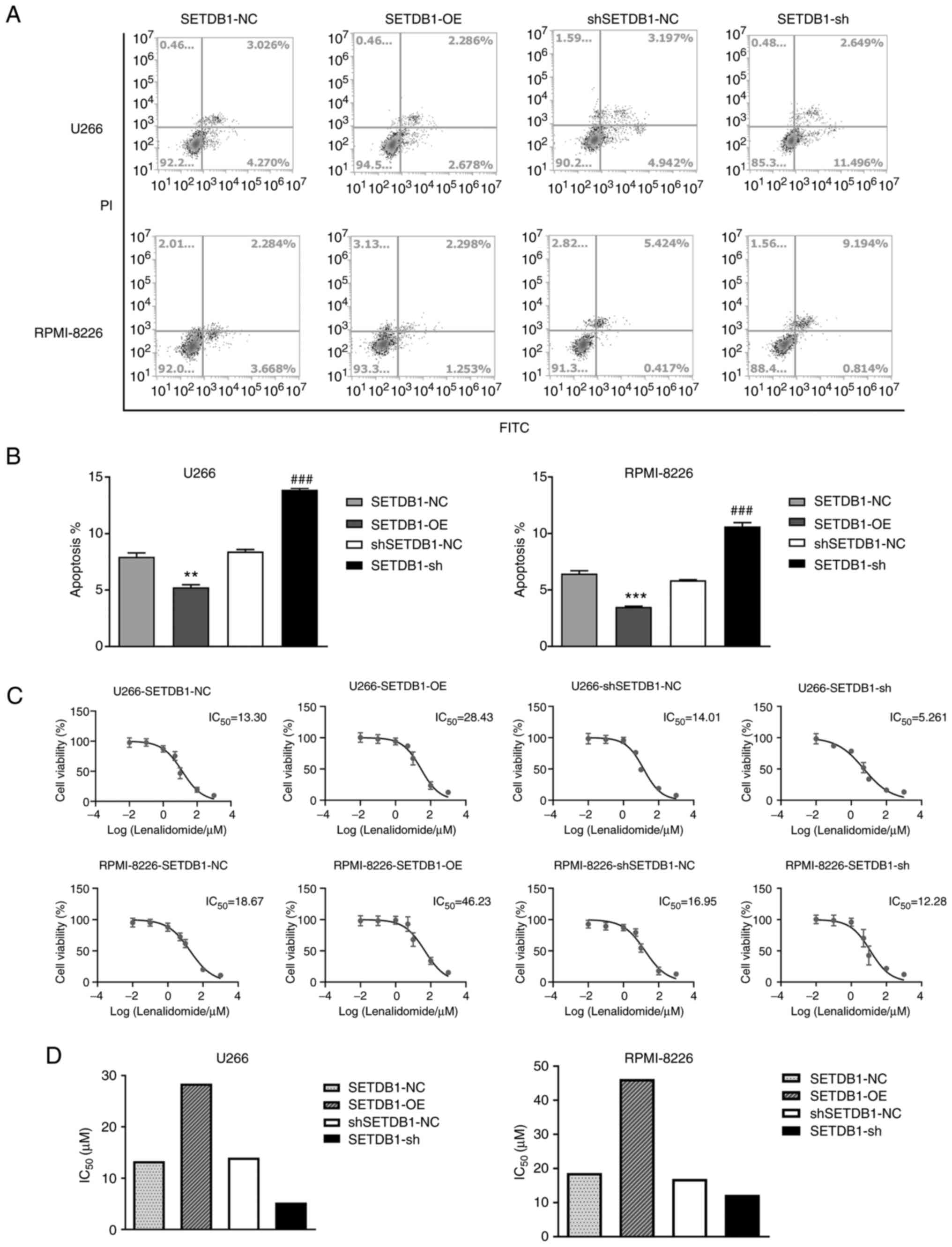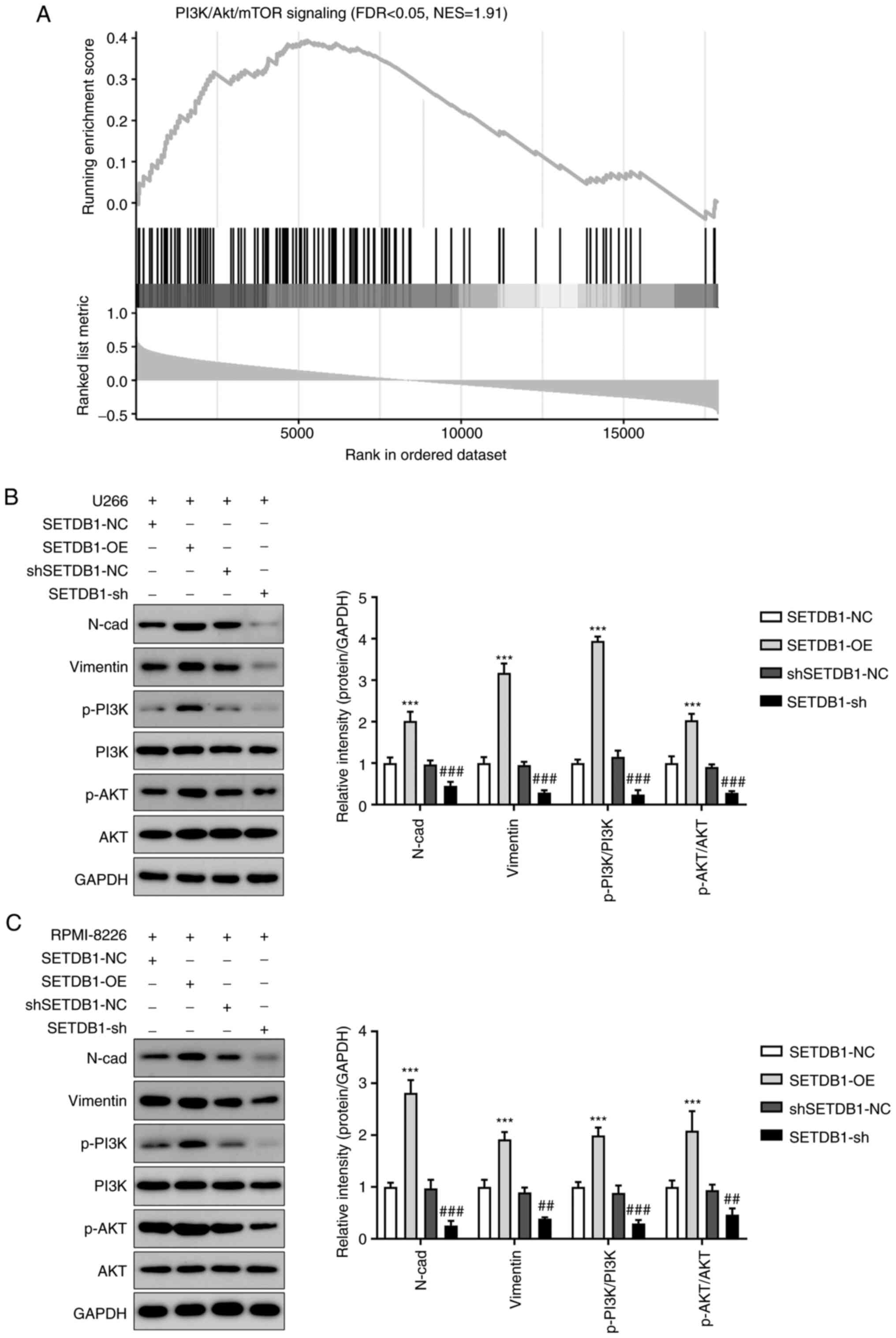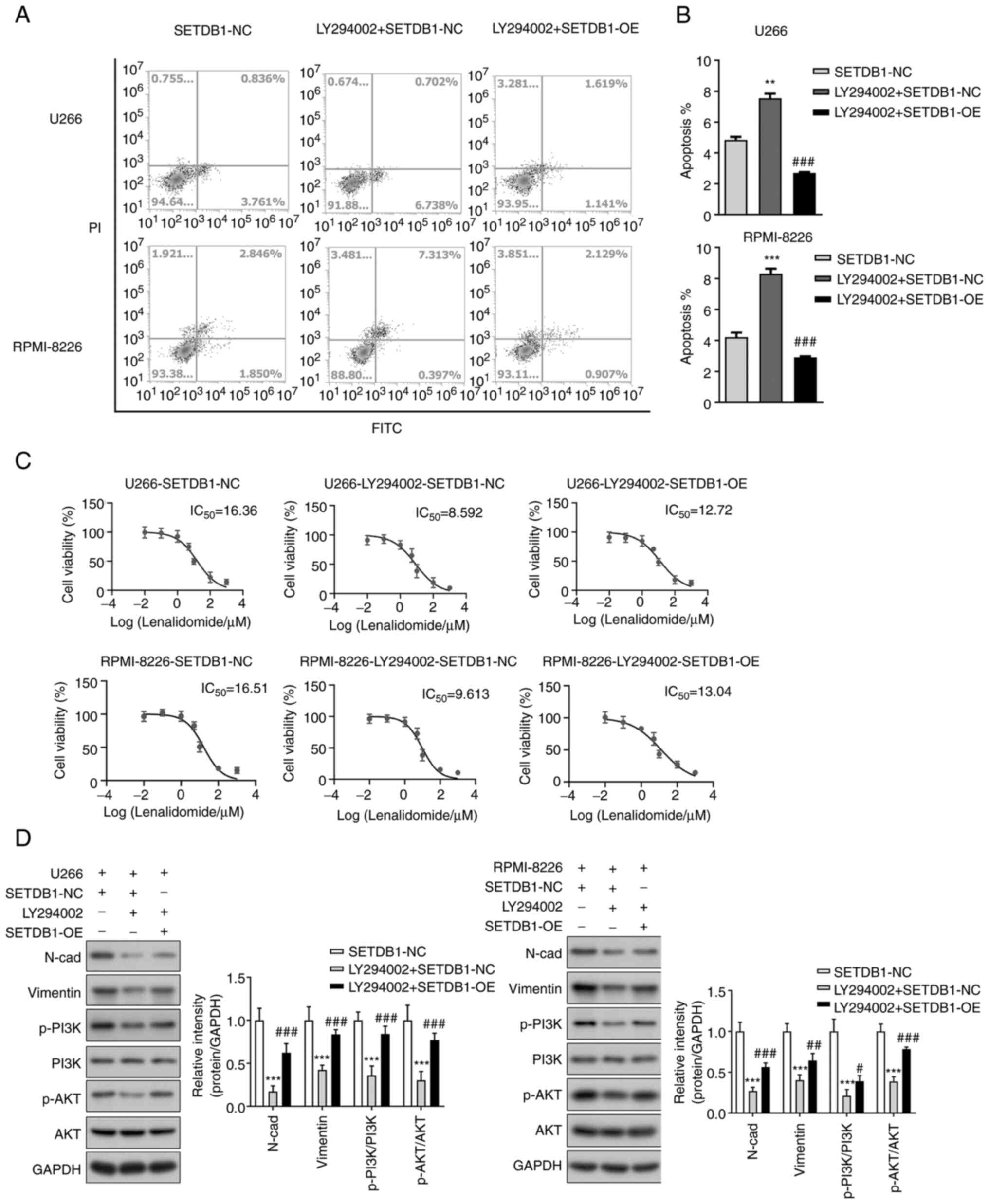|
1
|
Palumbo A and Anderson K: Multiple
myeloma. N Engl J Med. 364:1046–1060. 2011.PubMed/NCBI View Article : Google Scholar
|
|
2
|
Benboubker L, Dimopoulos MA, Dispenzieri
A, Catalano J, Belch AR, Cavo M, Pinto A, Weisel K, Ludwig H,
Bahlis N, et al: Lenalidomide and dexamethasone in
transplant-ineligible patients with myeloma. N Eng J Med.
371:906–917. 2014.PubMed/NCBI View Article : Google Scholar
|
|
3
|
Palumbo A, Hajek R, Delforge M, Kropff M,
Petrucci MT, Catalano J, Gisslinger H, Wiktor-Jędrzejczak W,
Zodelava M, Weisel K, et al: Continuous lenalidomide treatment for
newly diagnosed multiple myeloma. N Engl J Med. 366:1759–1769.
2012.PubMed/NCBI View Article : Google Scholar
|
|
4
|
Zonder JA, Crowley J, Hussein MA, Bolejack
V, Moore DF Sr, Whittenberger BF, Abidi MH, Durie BGM and Barlogie
B: Lenalidomide and high-dose dexamethasone compared with
dexamethasone as initial therapy for multiple myeloma: A randomized
Southwest oncology group trial (S0232). Blood. 116:5838–5841.
2010.PubMed/NCBI View Article : Google Scholar
|
|
5
|
Ng YLD, Ramberger E, Bohl SR, Dolnik A,
Steinebach C, Conrad T, Müller S, Popp O, Kull M, Haj M, et al:
Proteomic profiling reveals CDK6 upregulation as a targetable
resistance mechanism for lenalidomide in multiple myeloma. Nat
Commun. 13(1009)2022.PubMed/NCBI View Article : Google Scholar
|
|
6
|
Harte PJ, Wu W, Carrasquillo MM and Matera
AG: Assignment of a novel bifurcated SET domain gene, SETDB1, to
human chromosome band 1q21 by in situ hybridization and radiation
hybrids. Cytogenet Cell Genet. 84:83–86. 1999.PubMed/NCBI View Article : Google Scholar
|
|
7
|
Özdaş S: Knockdown of SET domain,
Bifurcated 1 suppresses head and neck cancer cell viability and
wound-healing ability in vitro. Turk J Biol. 43:281–292.
2019.PubMed/NCBI View Article : Google Scholar
|
|
8
|
Kang YK and Min B: SETDB1 overexpression
sets an intertumoral transcriptomic divergence in non-small cell
lung carcinoma. Front Genet. 11(573515)2020.PubMed/NCBI View Article : Google Scholar
|
|
9
|
Yang W, Su Y, Hou C, Chen L, Zhou D, Ren
K, Zhou Z, Zhang R and Liu X: SETDB1 induces epithelial-mesenchymal
transition in breast carcinoma by directly binding with Snail
promoter. Oncol Rep. 41:1284–1292. 2019.PubMed/NCBI View Article : Google Scholar
|
|
10
|
Wang W, Wang J, Zhang X and Liu G: Serum
circSETDB1 is a promising biomarker for predicting response to
platinum-taxane-combined chemotherapy and relapse in high-grade
serous ovarian cancer. Onco Targets Ther. 12:7451–7457.
2019.PubMed/NCBI View Article : Google Scholar
|
|
11
|
Ropa J, Saha N, Chen Z, Serio J, Chen W,
Mellacheruvu D, Zhao L, Basrur V, Nesvizhskii AI and Muntean AG:
PAF1 complex interactions with SETDB1 mediate promoter H3K9
methylation and transcriptional repression of Hoxa9 and Meis1 in
acute myeloid leukemia. Oncotarget. 9:22123–22136. 2018.PubMed/NCBI View Article : Google Scholar
|
|
12
|
Carvalho S, Freitas M, Antunes L,
Monteiro-Reis S, Vieira-Coimbra M, Tavares A, Paulino S, Videira
JF, Jerónimo C and Henrique R: Prognostic value of histone marks
H3K27me3 and H3K9me3 and modifying enzymes EZH2, SETDB1 and LSD-1
in colorectal cancer. J Cancer Res Clin Oncol. 144:2127–2137.
2018.PubMed/NCBI View Article : Google Scholar
|
|
13
|
Wang C, Xia Z, Li Z, Ye F, Ji S, Lu C and
Zhang H: Expression of SET domain bifurcated histone lysine
methyltransferase 1 and its clinical prognostic significance in
hepatocellular carcinoma. J Clin Lab Anal.
36(e24090)2022.PubMed/NCBI View Article : Google Scholar
|
|
14
|
Wang G, Long J, Gao Y, Zhang W, Han F, Xu
C, Sun L, Yang SC, Lan J, Hou Z, et al: SETDB1-mediated methylation
of Akt promotes its K63-linked ubiquitination and activation
leading to tumorigenesis. Nat Cell Biol. 21:214–225.
2019.PubMed/NCBI View Article : Google Scholar
|
|
15
|
Guo J, Dai X, Laurent B, Zheng N, Gan W,
Zhang J, Guo A, Yuan M, Liu P, Asara JM, et al: AKT methylation by
SETDB1 promotes AKT kinase activity and oncogenic functions. Nat
Cell Biol. 21:226–237. 2019.PubMed/NCBI View Article : Google Scholar
|
|
16
|
Kim SH, Juhnn YS and Song YS: Akt
involvement in paclitaxel chemoresistance of human ovarian cancer
cells. Ann N Y Acad Sci. 1095:82–89. 2007.PubMed/NCBI View Article : Google Scholar
|
|
17
|
Guerrero-Zotano A, Mayer IA and Arteaga
CL: PI3K/AKT/mTOR: Role in breast cancer progression, drug
resistance, and treatment. Cancer Metastasis Rev. 35:515–524.
2016.PubMed/NCBI View Article : Google Scholar
|
|
18
|
Shorning BY, Dass MS, Smalley MJ and
Pearson HB: The PI3K-AKT-mTOR pathway and prostate cancer: At the
crossroads of AR, MAPK, and WNT signaling. Int J Mol Sci.
21(4507)2020.PubMed/NCBI View Article : Google Scholar
|
|
19
|
Bloedjes TA, de Wilde G, Maas C, Eldering
E, Bende RJ, van Noesel CJM, Pals ST, Spaargaren M and Guikema JEJ:
AKT signaling restrains tumor suppressive functions of FOXO
transcription factors and GSK3 kinase in multiple myeloma. Blood
Adv. 4:4151–4164. 2020.PubMed/NCBI View Article : Google Scholar
|
|
20
|
Tsubaki M, Takeda T, Tomonari Y, Koumoto
YI, Imano M, Satou T and Nishida S: Overexpression of HIF-1α
contributes to melphalan resistance in multiple myeloma cells by
activation of ERK1/2, Akt, and NF-κB. Lab Invest. 99:72–84.
2019.PubMed/NCBI View Article : Google Scholar
|
|
21
|
Wang L, Lin N and Li Y: The PI3K/AKT
signaling pathway regulates ABCG2 expression and confers resistance
to chemotherapy in human multiple myeloma. Oncol Rep. 41:1678–1690.
2019.PubMed/NCBI View Article : Google Scholar
|
|
22
|
Schuster SR, Kortuem KM, Zhu YX, Braggio
E, Shi CX, Bruins LA, Schmidt JE, Ahmann G, Kumar S, Rajkumar SV,
et al: The clinical significance of cereblon expression in multiple
myeloma. Leuk Res. 38:23–28. 2014.PubMed/NCBI View Article : Google Scholar
|
|
23
|
Kortüm KM, Mai EK, Hanafiah NH, Shi CX,
Zhu YX, Bruins L, Barrio S, Jedlowski P, Merz M, Xu J, et al:
Targeted sequencing of refractory myeloma reveals a high incidence
of mutations in CRBN and Ras pathway genes. Blood. 128:1226–1233.
2016.PubMed/NCBI View Article : Google Scholar
|
|
24
|
Zhu YX, Braggio E, Shi CX, Kortuem KM,
Bruins LA, Schmidt JE, Chang XB, Langlais P, Luo M, Jedlowski P, et
al: Identification of cereblon-binding proteins and relationship
with response and survival after IMiDs in multiple myeloma. Blood.
124:536–545. 2014.PubMed/NCBI View Article : Google Scholar
|
|
25
|
Bjorklund CC, Ma W, Wang ZQ, Davis RE,
Kuhn DJ, Kornblau SM, Wang M, Shah JJ and Orlowski RZ: Evidence of
a role for activation of Wnt/beta-catenin signaling in the
resistance of plasma cells to lenalidomide. J Biol Chem.
286:11009–11020. 2011.PubMed/NCBI View Article : Google Scholar
|
|
26
|
Bjorklund CC, Baladandayuthapani V, Lin
HY, Jones RJ, Kuiatse I, Wang H, Yang J, Shah JJ, Thomas SK, Wang
M, et al: Evidence of a role for CD44 and cell adhesion in
mediating resistance to lenalidomide in multiple myeloma:
Therapeutic implications. Leukemia. 28:373–383. 2014.PubMed/NCBI View Article : Google Scholar
|
|
27
|
Ocio EM, Fernández-Lázaro D, San-Segundo
L, López-Corral L, Corchete LA, Gutiérrez NC, Garayoa M, Paíno T,
García-Gómez A, Delgado M, et al: In vivo murine model of acquired
resistance in myeloma reveals differential mechanisms for
lenalidomide and pomalidomide in combination with dexamethasone.
Leukemia. 29:705–714. 2015.PubMed/NCBI View Article : Google Scholar
|
|
28
|
Livak KJ and Schmittgen TD: Analysis of
relative gene expression data using real-time quantitative PCR and
the 2(-Delta Delta C(T)) method. Methods. 25:402–408.
2001.PubMed/NCBI View Article : Google Scholar
|
|
29
|
Danziger SA, McConnell M, Gockley J, Young
MH, Rosenthal A, Schmitz F, Reiss DJ, Farmer P, Alapat DV, Singh A,
et al: Bone marrow microenvironments that contribute to patient
outcomes in newly diagnosed multiple myeloma: A cohort study of
patients in the total therapy clinical trials. PLoS Med.
17(e1003323)2020.PubMed/NCBI View Article : Google Scholar
|
|
30
|
Yu G, Wang LG, Han Y and He QY:
clusterprofiler: An R package for comparing biological themes among
gene clusters. OMICS. 16:284–287. 2012.PubMed/NCBI View Article : Google Scholar
|
|
31
|
Li H, Han D, Hou Y, Chen H and Chen Z:
Statistical inference methods for two crossing survival curves: A
comparison of methods. PLoS One. 10(e0116774)2015.PubMed/NCBI View Article : Google Scholar
|
|
32
|
Mittal V: Epithelial mesenchymal
transition in tumor metastasis. Annu Rev Pathol. 13:395–412.
2018.PubMed/NCBI View Article : Google Scholar
|
|
33
|
Uddin S, Bu R, Ahmed M, Abubaker J,
Al-Dayel F, Bavi P and Al-Kuraya KS: Overexpression of leptin
receptor predicts an unfavorable outcome in Middle Eastern ovarian
cancer. Mol Cancer. 8(74)2009.PubMed/NCBI View Article : Google Scholar
|
|
34
|
Dimopoulos MA, Moreau P, Terpos E, Mateos
MV, Zweegman S, Cook G, Delforge M, Hájek R, Schjesvold F, Cavo M,
et al: Multiple myeloma: EHA-ESMO clinical practice guidelines for
diagnosis, treatment and follow-up†. Ann Oncol. 32:309–322.
2021.PubMed/NCBI View Article : Google Scholar
|
|
35
|
Martinez-Hoyer S and Karsan A: Mechanisms
of lenalidomide sensitivity and resistance. Exp Hematol. 91:22–31.
2020.PubMed/NCBI View Article : Google Scholar
|
|
36
|
Weber DM, Chen C, Niesvizky R, Wang M,
Belch A, Stadtmauer EA, Siegel D, Borrello I, Rajkumar SV,
Chanan-Khan AA, et al: Lenalidomide plus dexamethasone for relapsed
multiple myeloma in North America. N Engl J Med. 357:2133–2142.
2007.PubMed/NCBI View Article : Google Scholar
|
|
37
|
Richardson P, Jagannath S, Hussein M,
Berenson J, Singhal S, Irwin D, Williams SF, Bensinger W, Badros
AZ, Vescio R, et al: Safety and efficacy of single-agent
lenalidomide in patients with relapsed and refractory multiple
myeloma. Blood. 114:772–778. 2009.PubMed/NCBI View Article : Google Scholar
|
|
38
|
Strepkos D, Markouli M, Klonou A,
Papavassiliou AG and Piperi C: Histone Methyltransferase SETDB1: A
common denominator of tumorigenesis with therapeutic potential.
Cancer Res. 81:525–534. 2021.PubMed/NCBI View Article : Google Scholar
|
|
39
|
Cao N, Yu Y, Zhu H, Chen M, Chen P, Zhuo
M, Mao Y, Li L, Zhao Q, Wu M and Ye M: SETDB1 promotes the
progression of colorectal cancer via epigenetically silencing p21
expression. Cell Death Dis. 11(351)2020.PubMed/NCBI View Article : Google Scholar
|
|
40
|
Karanth AV, Maniswami RR, Prashanth S,
Govindaraj H, Padmavathy R, Jegatheesan SK, Mullangi R and
Rajagopal S: Emerging role of SETDB1 as a therapeutic target.
Expert Opin Ther Targets. 21:319–331. 2017.PubMed/NCBI View Article : Google Scholar
|
|
41
|
Zhou Z, Wu B, Tang X, Yang W, Zou Q and
Wang H: High SET domain Bifurcated 1 (SETDB1) expression predicts
poor prognosis in breast carcinoma. Med Sci Monit.
26(e922982)2020.PubMed/NCBI View Article : Google Scholar
|
|
42
|
Shang W, Wang Y, Liang X, Li T, Shao W,
Liu F, Cui X, Wang Y, Lv L, Chai L, et al: SETDB1 promotes gastric
carcinogenesis and metastasis via upregulation of CCND1 and MMP9
expression. J Pathol. 253:148–159. 2021.PubMed/NCBI View Article : Google Scholar
|
|
43
|
Yu L, Ye F, Li YY, Zhan YZ, Liu Y, Yan HM,
Fang Y, Xie YW, Zhang FJ, Chen LH, et al: Histone methyltransferase
SETDB1 promotes colorectal cancer proliferation through the
STAT1-CCND1/CDK6 axis. Carcinogenesis. 41:678–688. 2020.PubMed/NCBI View Article : Google Scholar
|
|
44
|
Guo C, Chu H, Gong Z, Zhang B, Li C, Chen
J and Huang L: HOXB13 promotes gastric cancer cell migration and
invasion via IGF-1R upregulation and subsequent activation of
PI3K/AKT/mTOR signaling pathway. Life Sci.
278(119522)2021.PubMed/NCBI View Article : Google Scholar
|
|
45
|
Bakr AG, El-Bahrawy AH, Taha HH and Ali
FEM: Diosmin enhances the anti-angiogenic activity of sildenafil
and pentoxifylline against hepatopulmonary syndrome via regulation
of TNF-alpha/VEGF, IGF-1/PI3K/AKT, and FGF-1/ANG-2 signaling
pathways. Eur J Pharmacol. 873(173008)2020.PubMed/NCBI View Article : Google Scholar
|
|
46
|
Chen C, Liu P, Duan X, Cheng M and Xu LX:
Deferoxamine-induced high expression of TfR1 and DMT1 enhanced iron
uptake in triple-negative breast cancer cells by activating
IL-6/PI3K/AKT pathway. Onco Targets Ther. 12:4359–4377.
2019.PubMed/NCBI View Article : Google Scholar
|
|
47
|
Dou R, Qian J, Wu W, Zhang Y, Yuan Y, Guo
M, Wei R, Yang S, Jurczyszyn A, Janz S, et al: Suppression of
steroid 5alpha-reductase type I promotes cellular apoptosis and
autophagy via PI3K/Akt/mTOR pathway in multiple myeloma. Cell Death
Dis. 12(206)2021.PubMed/NCBI View Article : Google Scholar
|
|
48
|
Xu Y, Feng X, Zhou Q, Jiang W, Dai Y,
Jiang Y, Liu X, Li S, Wang Y, Wang F, et al: Novel small molecular
compound AE-848 potently induces human multiple myeloma cell
apoptosis by modulating the NF-kappaB and PI3K/Akt/mTOR signaling
pathways. Onco Targets Ther. 13:13063–13075. 2020.PubMed/NCBI View Article : Google Scholar
|
|
49
|
Ramakrishnan V and Kumar S: PI3K/AKT/mTOR
pathway in multiple myeloma: from basic biology to clinical
promise. Leuk Lymphoma. 59:2524–2534. 2018.PubMed/NCBI View Article : Google Scholar
|
|
50
|
Li N, Liu B, Wang D, Song Y, Luo S and
Fang B: Preliminary study on the relationship among stem cell
markers, drug resistance and PI3K signaling pathway in multiple
myeloma (MM) cell. Transl Cancer Res. 9:3385–3391. 2020.PubMed/NCBI View Article : Google Scholar
|
|
51
|
Zhang Y and Weinberg RA:
Epithelial-to-mesenchymal transition in cancer: Complexity and
opportunities. Front Med. 12:361–373. 2018.PubMed/NCBI View Article : Google Scholar
|
|
52
|
Arumugam T, Ramachandran V, Fournier KF,
Wang H, Marquis L, Abbruzzese JL, Gallick GE, Logsdon CD, McConkey
DJ, Choi W, et al: Epithelial to mesenchymal transition contributes
to drug resistance in pancreatic cancer. Cancer Res. 69:5820–5828.
2009.PubMed/NCBI View Article : Google Scholar
|
|
53
|
McConkey DJ, Choi W, Marquis L, Martin F,
Williams MB, Shah J, Svatek R, Das A, Adam L, Kamat A, et al: Role
of epithelial-to-mesenchymal transition (EMT) in drug sensitivity
and metastasis in bladder cancer. Cancer Metastasis Rev.
28:335–344. 2009.PubMed/NCBI View Article : Google Scholar
|
|
54
|
Huang J, Li H and Ren G:
Epithelial-mesenchymal transition and drug resistance in breast
cancer (Review). Int J Oncol. 47:840–848. 2015.PubMed/NCBI View Article : Google Scholar
|
|
55
|
Ryu J, Koh Y, Park H, Kim DY, Kim DC, Byn
JM, Lee HJ and Yoon SS: Highly expressed integrin-α8 induces
epithelial to mesenchymal transition-like features in multiple
myeloma with early relapse. Mol Cells. 39:898–908. 2016.PubMed/NCBI View Article : Google Scholar
|
|
56
|
Peng Y, Li F, Zhang P, Wang X, Shen Y,
Feng Y, Jia Y, Zhang R, Hu J and He A: IGF-1 promotes multiple
myeloma progression through PI3K/Akt-mediated
epithelial-mesenchymal transition. Life Sci.
249(117503)2020.PubMed/NCBI View Article : Google Scholar
|
|
57
|
Hou Z, Sun L, Xu F, Hu F, Lan J, Song D,
Feng Y, Wang J, Luo X, Hu J and Wang G: Blocking histone
methyltransferase SETDB1 inhibits tumorigenesis and enhances
cetuximab sensitivity in colorectal cancer. Cancer Lett. 487:63–73.
2020.PubMed/NCBI View Article : Google Scholar
|



















